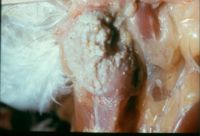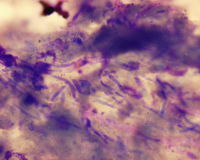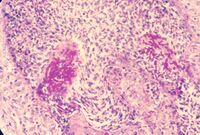Difference between revisions of "Candida spp."
Jump to navigation
Jump to search
| Line 51: | Line 51: | ||
*''Candida'' spp. in [[Mycotic skin infections - Pathology#Candidiasis|candidiasis]][[Category:Yeast-like Fungi]] | *''Candida'' spp. in [[Mycotic skin infections - Pathology#Candidiasis|candidiasis]][[Category:Yeast-like Fungi]] | ||
[[Category:Tongue_-_Pathology]] | [[Category:Tongue_-_Pathology]] | ||
| + | [[Category:To_Do_-_Fungi]] | ||
Revision as of 11:29, 25 June 2010
- Candidia albicans is the most important species
- C. tropicalis and C. pelliculosa are other important species
- World wide distribution
- Usually an endogenous mycoses
- Immunocompromised animals may show symptoms
- Usually lesions on mucous membranes and at mucocutaneous junctions
- Many species have been implicated in bovine mastitis
- C. albicans has been isolated in porcine stomach ulcers
- C. rugosa has been implicated in pyometra in mares
- Infection of the crop, oesophagus and mouth occur in poultry and other birds leading to sour crop
- Causes thrush in humans
- Affects the tongue
- C. albicans causes metritis and vaginitis in mares and genital candidiosis in stallions (and bulls)
- Skin scrapings in 20% KOH for microscopy
- Diphtheritic membranes, pus and fluids can be examined by Lactophenol Cotton Blue and stained by Gram or Methylene Blue stain
- Gram positive, oval, thin-walled budding cells with hyphal fragments
- Grow on Blood agar and Sabouraud's Dextrose agar producing soft, creamy colonies in 24-48 hours
- Grossly:
- Exudative, papular, pustular to ulcerative dermatitis
- Stomatitis and otitis externa may develop
- Microscopically:
- Spongiotic neutrophilic pustular inflammation
- Parakeratosis
- Ulcerations
- Superficial exudate containing organisms
- Candida spp. in candidiasis


